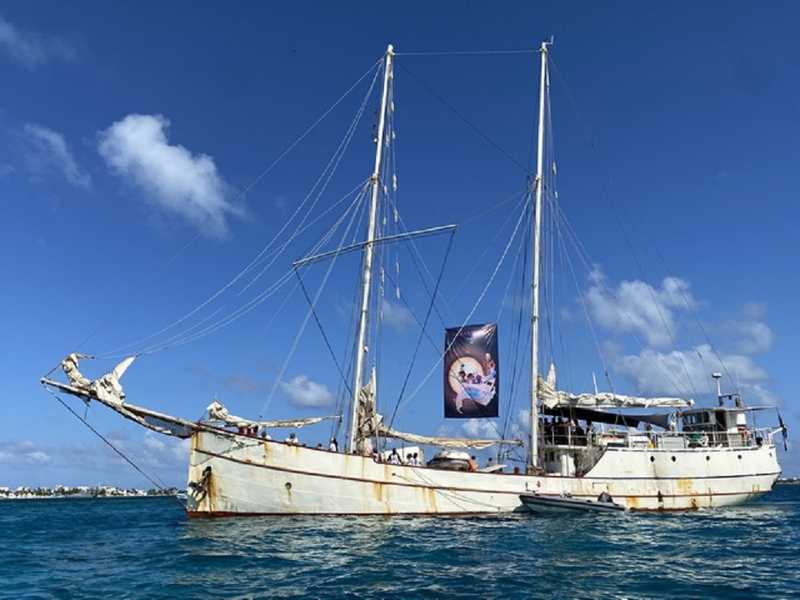
Editorial Note: The Zapatistas completed the first leg of their journey, making landfall in Spain after sailing across the open ocean from Mexico. The piece below, written as their journey began, explains the motivation behind the “invasion.” See here for the latest updates from the Zapatistas themselves.
It was a genuine surprise when the Zapatistas published their communiqué “A Mountain on the High Seas” on October 5, 2020, announcing a tour of the EZLN (Ejército Zapatista de Liberación Nacional) across five continents, starting with Europe. Even though the Zapatistas have not shied away from organizing initiatives in Chiapas and across Mexico — the March of the Color of the Earth just 20 years ago is a case in point — it is basically the first time since 1994 that they are leaving the borders of their homeland behind.
Then, on January 1 of this year, they published a Declaration for Life, co-signed with hundreds of individuals, collectives and organizations, outlining the objective of this voyage: making a contribution to the effort for anti-capitalist struggles — which are inseparable from the struggles for life — to converge in full consciousness of their differences and unhampered by homogenizing or hegemonizing forces.
In the past six months, extensive organizing has taken place at the European level, as well as in each individual country or “geography,” according to the Zapatista vocabulary. For instance, a francophone coordinating body has been established, which includes eight regional federations of collectives and local initiatives.
Meanwhile, the EZLN confirmed that a large delegation of more than a hundred members, three-quarters of which are women, was getting ready. The delegation is also said to be accompanied by members of the National Indigenous Congress–Indigenous Council of Government which unites Indigenous struggles across Mexico, as well as a contingent of the People’s Front in Defense of Land and Water of Puebla, Morelos and Tlaxcala which is fighting against the installation of a massive power plant that is threatening to divert water resources indispensable to the peasants in the region.
THE VOYAGE FOR LIFE — EUROPE CHAPTER
On April 10, the anniversary of Emiliano Zapata’s assassination, they announced the departure of the first party of the Zapatista delegation, destined to make its voyage by sea. We had expected to see them leave the caracol of Morelia that day, where the members had been preparing themselves for months. A formal ritual was performed for the occasion, with traditional music, incense and purifying acts (“limpia”), upon a life-size model of a ship’s prow.
But the group did not set out on their journey right away: first they went into a 15-day quarantine to ensure that no one leaves the Zapatista territory carrying any other virus than that of rebellion. This decision is in line with the EZLN’s resolution to take all the required precautionary sanitary measures to avoid the spread of COVID-19 upon themselves and outside of state mandates. This had led them to issue a red alert and close off access to all Zapatista caracoles since March 15, 2020.
The maritime delegation was baptized “Escuadrón 421” because it is composed of four women, two men and one transgender person (“unoa otroa” in the Zapatista lexicon), who were individually introduced in a communique of Subcomandante Galeano.
Escuadrón 421
After another farewell party on Sunday, April 25, accompanied by the exhibition of numerous paintings and sculptures, encouraging speeches by the Council of Good Government and a communal ball, the delegation departed the next day from Morelia. From there they reached the Mexican harbor at Isla Mujeres where a ship named “La Montaña” was awaiting them and they set sail for the Atlantic crossing on May 2. The Escadron 421 is now at the mercy of the ocean’s wiles, under the capable seamanship of the ship’s crew. They should be within sight of the European coast at the port of Vigo in Spain in the second half of June.
Simultaneously smaller celebrations were organized by the sound of drums and all sorts of encouragements to accompany the departure of other members of the Zapatista delegation, leaving their villages in the Lacandon jungle, at times using canoes to descent the rivers of this tropical region close to the Guatemalan border. They are part of different groups of the Zapatista delegation, which will reach the old continent, by air travel this time, from the beginning of July onwards.
So will begin months of intensive activities, meetings and exchanges all over Europa for the Zapatistas. Thus far they have received and accepted invitations from a great number of “geographies”: Austria, Basque Country, Belgium, Bulgaria, Catalonia, Croatia, Cyprus, Denmark, Finland, France, Germany, Greece, Hungary, Italy, Luxembourg, Norway, Netherlands, Poland, Portugal, Romania, Russia, Sardinia, Serbia, Slovenia, Spain, Sweden, Switzerland, Turkey, UK and Ukraine.
Hundreds of meetings and activities have been proposed to the Zapatistas, which are currently being coordinated. These events will be made public by the organizing collectives when the time comes. This might also include larger gatherings/rallies, around all current struggles: from the Gilets Jaunes to ZAD’s, in the case of France, and other resistance groups fighting destructive mega projects; feminist collectives, migrant support initiatives, groups struggling against police violence, as well as movements aiming to undo colonial forms of domination; mutual aid networks based in cities and rural areas as well as those involved in building alternative ways of living; not forgetting the critical mobilizing efforts compelled by, as the Zapatistas emphasize, the bloody tragedies of our wounded planet. The list — incomplete here — is long in the vast constellation of rebellions against capitalist brutality and struggles for other, more desirable worlds.
Above all, the Zapatistas have explained that they are coming to exchange with — that is, to speak, and even more so, to listen to — all those that have invited them “to talk about our mutual histories, our sufferings, our rages, our successes and our failures.” Especially in grassroots meetings so there is enough time to get to know and learn from one another.
The Zapatistas have long since argued for our struggles not to remain isolated from each other, and have underlined the importance of constructing global networks of resistance and rebellion. There is no need to enumerate all the international events that they have organized in Chiapas from the First Intercontinental Encounter for Humanity and against Neoliberalism (also referred to as “Intergalactic”) in 1996 until the Critical Thought in the Face of the Capitalist Hydra seminar in 2015. But in August 2019, while announcing the recent advancement in local self-government with the establishment of four new autonomous communes and seven new Councils of Good Government, the Zapatistas had made it clear not to be organizing any large events anymore. Instead they were planning to take part in “meetings with groups, collectives, and organizations that work [struggle] within their geographies.”
There was no question back then of touring the five continents, but it could be — among many other reasons to set out on such a journey — a way to initiate this very process. If such an approach may indeed resonate with the widely felt need to weave stronger bonds between existing struggles, this requires not only an exchange to identify the commonalities and differences but especially a human-to-human encounter that can forge interconnection.
The Zapatistas are calling this journey the “Voyage for Life,” and it will present an opportunity for a vast number of people to meet the Zapatistas and learn more from their experiment in autonomy and dignity, persevered against overwhelming odds for over a quarter century. And, hopefully, many will allow themselves to be won over by the virus of rebellion of which the Zapatista are contagious carriers.
Let’s also hope that all those who identify with the Declaration for Life and for whom the autonomy of the Zapatista is a shining source of aspiration and inspiration will be ready to welcome them, support their itinerant initiative and participate in a manner best suited to each and every one on this Voyage for Life.
THE CONTINENT RENAMED “SLUMIL K’AJXEMK’OP”
Returning to the Escadron 421. Since the first announcement, the Zapatistas have talked about their voyage towards Europe as a reversed process of conquest. The idea of the inversed invasion — this time with consent — amuses them. Obviously, it is said in jest — but are we entirely sure? When the delegation left, scale models ironically alluded to the caravels of Christopher Columbus: “No soy una Niña” and “Santa Maria La Revancha”; but it was also clarified that it is only if the members of Squadron 421 manage to land on European soil that it can be truly said that “the invasion has started.” If all goes well, they will be in Madrid on August 13, 2021, to celebrate in their own way the quincentenary of the conquest of Mexico-Tenochtitlan by the army of Hernan Cortés.
The Indigenous population of Chiapas, like all those on the American continent, have for five centuries suffered the implications of colonization, including all the forms of internal colonialism and racism that extend it. The Zapatistas have made it clear, however, that they are not coming to Madrid to get a formal apology from the Spanish state or the Catholic church. They reject the essentialist condemnation of the “West” as evil and fully assimilated to the colonizers, as well as the attitude that relegates the colonized to the role of victim. On the contrary, they are intending to tell the Spaniards “that they have not conquered us [and] that we are still resisting and in fact in open rebellion.”
The ship La Montaña that brought the Zapatistas to Europe.
To make this voyage in reverse is to nuance a history that has assigned deeply entrenched and unambiguous positions to the vanquisher and the vanquished, and unlock the possibility for an alternative history.
When the maritime Zapatista delegation reaches Europe it is Marijose, “unoa otroa” of the Escadron 421 that will go ashore first. The following is how Subcomandante Galeano described the scene in advance; an inversion of the gesture by which Christopher Columbus — who disembarked on October 12, 1492, neither as a conqueror nor as a discoverer, since he was only seeking to find the already known lands of Japan and China — rushed to plant his cross and impose the name San Salvador on the island of Guanahaní:
Thus, the first foot that will set on European soil (that is, if they let us disembark) will not be that of man or a woman. It will be the foot of another.
With what the deceased SupMarcos would have described as “a slap with a black stocking in the face of all the heteropatriarchal left,” it has been decided that the first person to disembark will be Marijose.
As soon as they will have planted both feet firmly on European ground and recovered from seasickness, Marijose will shout out:
“Surrender, pale heteropatriarchal faces who persecute that which is different!”
Nah, I’m joking. But wouldn’t it be good if they did?
No, on stepping out on land the Zapatista compa Marijose will solemnly declare:
“In the name of women, of children, of men, of elders and, of course, of other Zapatistas, I declare that the name of this land, which its natives today call “Europe” will henceforth be known as: SLUMIL K’AJXEMK’OP, which means “Rebel Land,” or, “Land that doesn’t yield, that doesn’t fail.”
And thus it will be known by its inhabitants as well as by strangers as long as there is someone who will not abandon, who will not sell out, and who will not capitulate.”
Welcome, compañeroas, compañeras and compañeros zapatistas, to the diverse geographies of the continent that will soon be renamed Slumil K’ajxemk’op.
Jérôme Baschet is a historian and a long-term research professor at EHESS (Paris). He currently teaches at the Universidad Autonoma de Chiapas (San Cristobal Las Casas, Mexico). He is the author of Adieux au capitalisme. Autonomie, société du bien vivre et multiplicité des mondes (2014) and of Rebeldia, resistencia y autonomia. La experiencia zapatista (2018).



